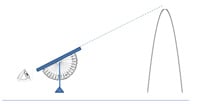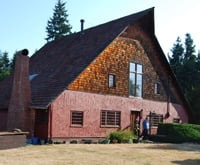By Chuck Newcombe

A recent Imagine Children's Museum summer activity for kids at a park near my home got me to thinking - here's a good opportunity to teach kids about the mathematical principles first publicized by the Greeks (Pythagoras, among others).
It seems the kids were decorating empty plastic soda bottles, filling them half full of water and then launching them as rockets powered by air pressure. They pressurized them using a bicycle pump to charge the launcher.
What I want to add to a future Fluke-sponsored i-Engineers activity is another kid using an instrument to estimate the height these rockets reach. The instrument to be used will be made using a soda straw (sighting tube) glued to a protractor, to measure the angle of inclination, with a string and a plumb bob to establish a vertical reference for the angle measurement. Completing the experiment will require the user to be located a known distance, maybe 100 feet from the launch site, and a table of tangents to convert the angle measured to an equivalent height achieved by the rocket. Oh, we'll also need the height of the observer's eye from the ground - to be added to the overall measured height.
The new Fluke 42xD series of laser distance meters


I recently noted that Fluke has introduced a new family of laser distance meters with all kinds of features, including the ability to measure incline angles such as the ones discussed above. Unfortunately, while these tools will be very useful in evaluating distances, angles, areas and volumes in structures, they aren't really practical for the experiment I've just described, for a host of reasons - not the least of which would be trying to get the laser spot centered on a moving object at a distance in daylight.
So, what can these new Fluke meters do? The Fluke marketing staff loaned me a Fluke 424D so I could give you my take on that question. I decided to use an historic pole barn, which has been converted into a home, for my evaluation exercises.
I quickly determined the ceiling height of the main floor great room by setting the meter on end on the floor, pressing the Measure button once to enable the laser, and then pressing the timer button (letting the meter do the rest), counting down the default 5 seconds before taking a stable reading of 7 feet 11 inches.
Next, I used the Area/Volume button to find the length, width, and area of the room in two measurements. My readings were 51 feet 5 inches by 18 feet 2 inches. The meter showed me both readings along with the calculated area of 934 ft².
"But, you could do this with a tape measure and a calculator?" you say. Well, you're right, but each measurement was made from a single location without an assistant to hold the other end of the tape, and the calculation is done for you. And, you can make such measurements to over 100 feet with even the least expensive model Fluke 414D. One added benefit of the more capable Fluke 419D and Fluke 424D models is that you can save your measurement sets, including calculations, in memory for later transcription to your documents.
Back to my investigation

Adding the kitchen, laundry, two bedrooms, a bath, and two hallways brought the area of the main floor of the home to just under 2,000 ft². And, I completed the task in minutes.
The really interesting part of my experiment was to evaluate the loft above the main living space. This has been left more or less as an open space, although a bathroom and a wet bar have been added to one end.
In the original barn, this loft would have been used for hay storage, so having a large open area with high ceiling is perfectly appropriate.
As you can see in the picture, there is considerable pole structure to support the roof while leaving uncluttered open space in the middle. The side structures come down to align with the posts and supports in the living space below.
As you can readily see, the big measurement problem here is to measure to the peak of the cathedral-like space. Not a problem for the trusty Fluke 424D. I measured 22 feet 2 inches from the floor to the peak, without the aid of a scaffold or ladder. With measures of 37 feet 6 inches and 25 feet between the walls, I added another 938 ft² to this novel home.
I didn't have an opportunity to fully test the angle measurement capabilities of the Fluke 424D, but I did calibrate the 8-point compass, including correction for magnetic north pole declination.
You can take your measurements in feet, feet and inches, inches, or meters, with options for display. And you can convert between these systems for measurements stored in memory.
I think I can safely say that Fluke has added yet another laborsaving tool to your toolbox with the introduction of these innovative new meters.